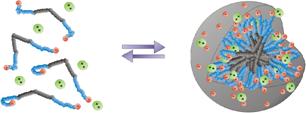268a Development of Ion-Selective Thermo-Reversible Polymers
Hardness ions like calcium and barium cause problems in many processes by forming unwanted salt depositions. For different applications, ranging from household applications like laundry and dish washing to drinking water processes, softening of water streams is essentially. The current technology to bind multivalent cations commonly is based on the use of ion exchange resins. Regeneration of these resins typically involves consecutive washing steps with acid or caustic, leading to a large amount of waste salts.
This research project focuses on the development of a new softening technology where regeneration of hardness ions occurs by a change in temperature. In this project Pluronics, triblock copolymer surfactants of PEO-PPO-PEO, are use. The main feature of Pluronic surfactants is the ability to show temperature dependent aggregation behavior.
Pluronic surfactants are available with different critical micellization temperatures (CMTs). In this project Pluronic surfactant P-85 is used. To allow for the reversible binding of multivalent cations, P-85 has been modified to yield a triblock copolymer with carboxylic acid end standing groups (CAE-85) [1] (Fig. 1).

Fig. 1: Chemical structure of CAE-85 surfactant
At a temperature below the CMT (below 30°C), the CAE-85 surfactant and the multivalent cations are present in solution as free unimers. The affinity of isolated carboxylic acid groups for multivalent cations is very low. Increasing the temperature above the CMT brings the charged groups together, which enables the micelle to bind multivalent ions (Fig. 2).

Fig. 2: Mechanism of thermo-reversible cation binding for CAE surfactants
Isothermal titration calorimetry (ITC) measurements have been performed with various mono- and multivalent metalchlorides to gain more insight in the binding mechanism of CAE-85. In these experiments, the metalchlorides were added dropwise to a solution of surfactant in water. While adding the metalchloride, the heat effect was measured.
To evaluate the influence of the addition of divalent cations on the behavior of the monovalent ions Eisenberg plots have been constructed. In these graphs the molar conductivity is plotted as a function of the monovalent molar equivalent conductivity of Li+, Na+ and K+.
References
[1] Custers, J.P.A., Kelemen, P., Van den Broeke, L.J.P., Cohen-Stuart, M.A.,